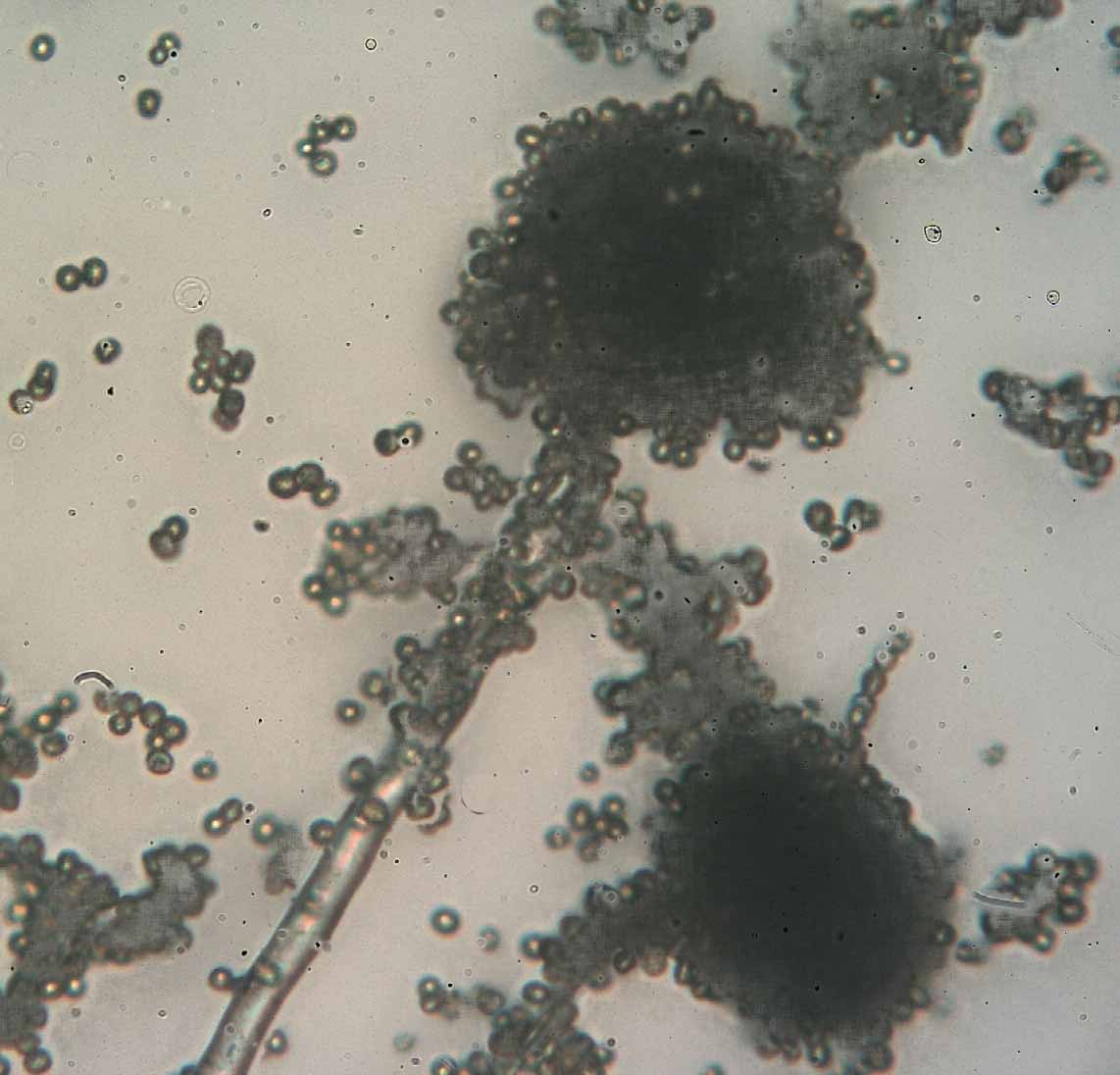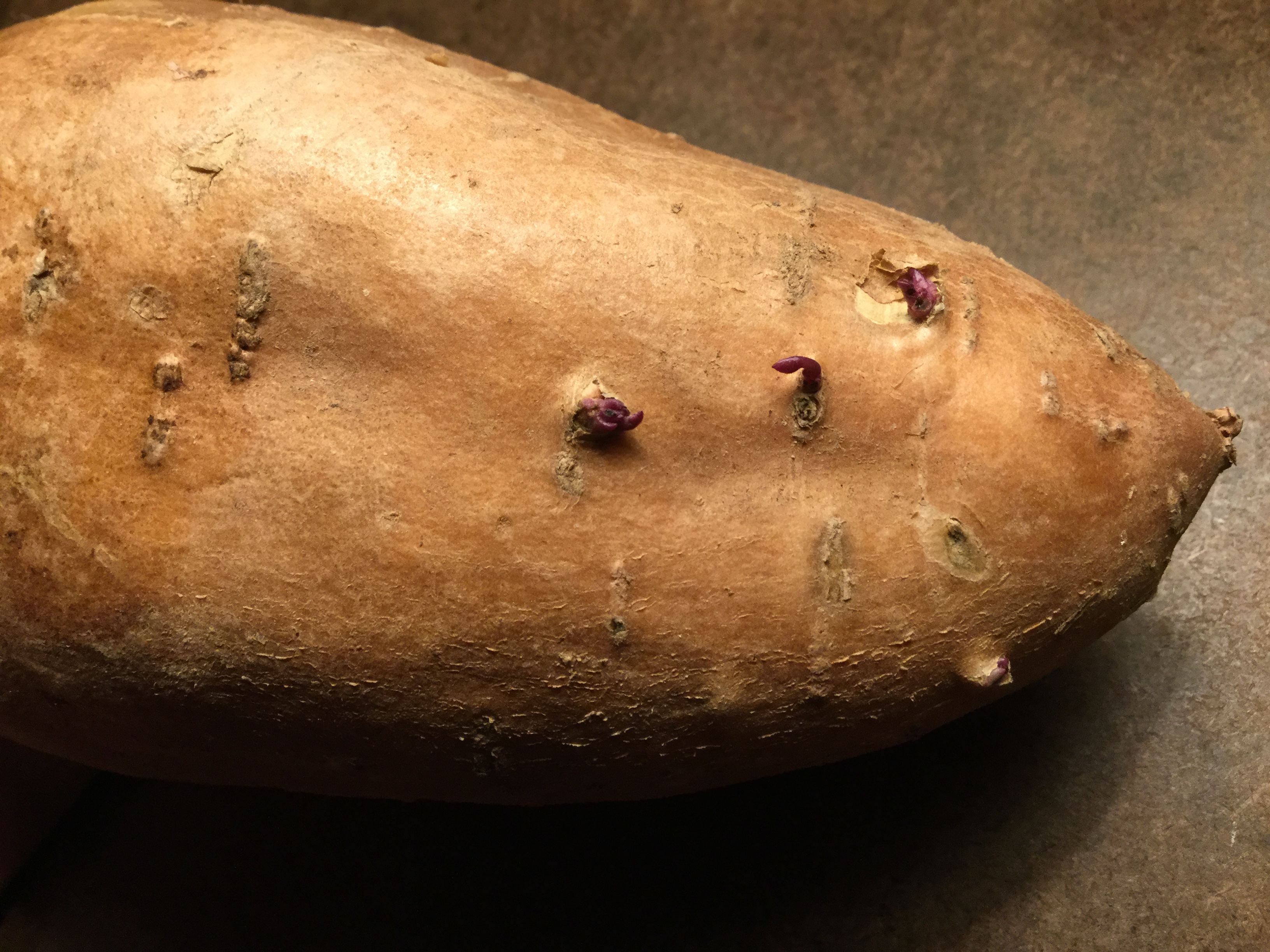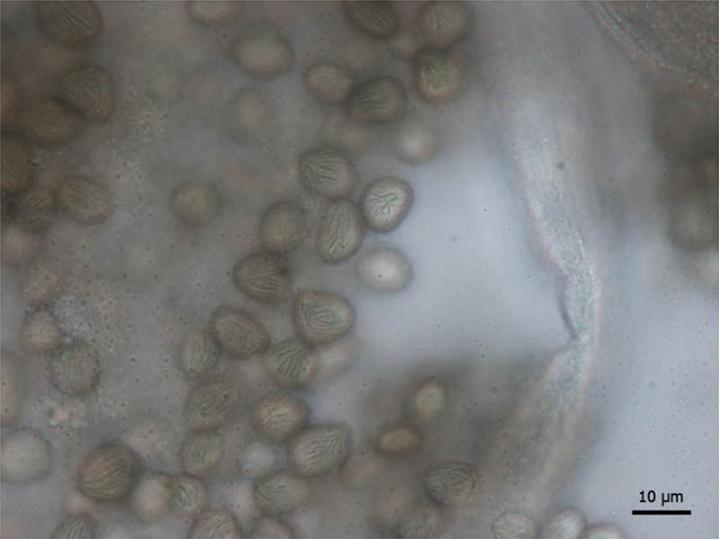|
Rhizopus Delemar
''Rhizopus'' is a genus of common saprophytic fungi on plants and specialized parasites on animals. They are found in a wide variety of organic substances, including "mature fruits and vegetables", jellies, syrups, leather, bread, peanuts, and tobacco. They are multicellular. Some ''Rhizopus'' species are opportunistic human pathogens that often cause fatal disease called mucormycosis. This widespread genus includes at least eight species. ''Rhizopus'' species grow as filamentous, branching hyphae that generally lack cross-walls (i.e., they are coenocytic). They reproduce by forming asexual and sexual spores. In asexual reproduction, sporangiospores are produced inside a spherical structure, the sporangium. Sporangia are supported by a large apophysate columella atop a long stalk, the sporangiophore. Sporangiophores arise among distinctive, root-like rhizoids. In sexual reproduction, a dark zygospore is produced at the point where two compatible mycelia fuse. Upon germinatio ... [...More Info...] [...Related Items...] OR: [Wikipedia] [Google] [Baidu] |
Mycelium
Mycelium (plural mycelia) is a root-like structure of a fungus consisting of a mass of branching, thread-like hyphae. Fungal colonies composed of mycelium are found in and on soil and many other substrates. A typical single spore germinates into a monokaryotic mycelium, which cannot reproduce sexually; when two compatible monokaryotic mycelia join and form a dikaryotic mycelium, that mycelium may form fruiting bodies such as mushrooms. A mycelium may be minute, forming a colony that is too small to see, or may grow to span thousands of acres as in ''Armillaria''. Through the mycelium, a fungus absorbs nutrients from its environment. It does this in a two-stage process. First, the hyphae secrete enzymes onto or into the food source, which break down biological polymers into smaller units such as monomers. These monomers are then absorbed into the mycelium by facilitated diffusion and active transport. Mycelia are vital in terrestrial and aquatic ecosystems for their role ... [...More Info...] [...Related Items...] OR: [Wikipedia] [Google] [Baidu] |
Rhizopus Arrhizus
''Rhizopus arrhizus'' is a fungus of the family Mucoraceae, characterized by sporangiophores that arise from nodes at the point where the rhizoids are formed and by a hemispherical columella. It is the most common cause of mucormycosis in humans and occasionally infects other animals. ''Rhizopus arrhizus'' spores contain ribosomes as a spore ultrastructure. Metabolism in the fungus changes from aerobic to fermentation at various points in its life cycle. Nutrition ''R. arrhizus'' produces siderophores which are also usable to adjacent plants. Holzberg & Artis 1983 finds a hydroxamate siderophore and Shenker et al 1992 provides a method for detection of a carboxylate. Plant diseases See: * List of almond diseases * List of apricot diseases * List of beet diseases * List of carrot diseases * List of mango diseases * List of maize diseases * List of peach and nectarine diseases * List of sunflower diseases ''R. arrhizus'' does not infect grape A grape is a fruit, botanica ... [...More Info...] [...Related Items...] OR: [Wikipedia] [Google] [Baidu] |
Rhizopus Americanus
''Rhizopus'' is a genus of common saprophytic fungi on plants and specialized parasites on animals. They are found in a wide variety of organic substances, including "mature fruits and vegetables", jellies, syrups, leather, bread, peanuts, and tobacco. They are multicellular. Some ''Rhizopus'' species are opportunistic human pathogens that often cause fatal disease called mucormycosis. This widespread genus includes at least eight species. ''Rhizopus'' species grow as filamentous, branching hyphae that generally lack cross-walls (i.e., they are coenocytic). They reproduce by forming asexual and sexual spores. In asexual reproduction, sporangiospores are produced inside a spherical structure, the sporangium. Sporangia are supported by a large apophysate columella atop a long stalk, the sporangiophore. Sporangiophores arise among distinctive, root-like rhizoids. In sexual reproduction, a dark zygospore is produced at the point where two compatible mycelia fuse. Upon germinati ... [...More Info...] [...Related Items...] OR: [Wikipedia] [Google] [Baidu] |
Narcissus (plant)
''Narcissus'' is a genus of predominantly spring flowering perennial plants of the amaryllis family, Amaryllidaceae. Various common names including daffodil,The word "daffodil" is also applied to related genera such as ''Sternbergia'', ''Ismene'' and '' Fritillaria meleagris''. It has been suggested that the word "Daffodil" be restricted to the wild species of the British Isles, '' N. pseudonarcissus''. narcissus, and jonquil are used to describe all or some members of the genus. ''Narcissus'' has conspicuous flowers with six petal-like tepals surmounted by a cup- or trumpet-shaped corona. The flowers are generally white and yellow (also orange or pink in garden varieties), with either uniform or contrasting coloured tepals and corona. ''Narcissus'' were well known in ancient civilisation, both medicinally and botanically, but formally described by Linnaeus in his ''Species Plantarum'' (1753). The genus is generally considered to have about ten sections with approximately ... [...More Info...] [...Related Items...] OR: [Wikipedia] [Google] [Baidu] |
Sweet Potatoes
The sweet potato or sweetpotato ('' Ipomoea batatas'') is a dicotyledonous plant that belongs to the bindweed or morning glory family, Convolvulaceae. Its large, starchy, sweet-tasting tuberous roots are used as a root vegetable. The young shoots and leaves are sometimes eaten as greens. Cultivars of the sweet potato have been bred to bear tubers with flesh and skin of various colors. Sweet potato is only distantly related to the common potato (''Solanum tuberosum''), both being in the order Solanales. Although darker sweet potatoes are often referred to as "yams" in parts of North America, the species is not a true yam, which are monocots in the order Dioscoreales. Sweet potato is native to the tropical regions of the Americas. Of the approximately 50 genera and more than 1,000 species of Convolvulaceae, ''I. batatas'' is the only crop plant of major importance—some others are used locally (e.g., ''I. aquatica'' "kangkong"), but many are poisonous. The genus ''Ipomoea'' ... [...More Info...] [...Related Items...] OR: [Wikipedia] [Google] [Baidu] |
Rhizopus Soft Rot
Rhizopus soft rot is a disease of the sweet potato. It is one of the most common to affect the sweet potato, happening during packing and shipping. The disease causes a watery soft rot of the internal portion of the storage root. Strategies to manage the disease include the development of resistant varieties, curing through the use of heat and humidity, and application of decay control products. Background Sweet potatoes are susceptible to a number of diseases during the postharvest storage period and during shipping.Clark, C.A. and Moyer, J.W. 1988. Compendium of sweet potato diseases. APS Press, St. Paul, MN. 74pp. The most common are Rhizopus soft rot (''Rhizopus stolonifer''), bacterial soft rot (''Erwinia chrysanthemii''), Fusarium root rot (''Fusarium solani''), Fusarium surface rot (''Fusarium oxysporum''), and black rot (''Ceratocystis fimbriata''). ''R. stolonifer'' is a problematic pathogen as it infects fresh wounds occurring during packing and shipping. Ther ... [...More Info...] [...Related Items...] OR: [Wikipedia] [Google] [Baidu] |
Cortisone
Cortisone is a pregnene (21-carbon) steroid hormone. It is a naturally-occurring corticosteroid metabolite that is also used as a pharmaceutical prodrug; it is not synthesized in the adrenal glands. Cortisol is converted by the action of the enzyme corticosteroid 11-beta-dehydrogenase isozyme 2 into the inactive metabolite cortisone, particularly in the kidneys. Cortisone is converted back to the active steroid cortisol by the action of the enzyme 11β-Hydroxysteroid dehydrogenase type 1, particularly in the liver. The term "cortisone" is frequently misused to mean either any corticosteroid or hydrocortisone, which is actually another name for cortisol. Many who speak of receiving a "cortisone shot" or taking "cortisone" are actually receiving hydrocortisone or one of many other, much more potent synthetic corticosteroids; it is unlikely that the drug administered is actually cortisone. Cortisone can be administered as a prodrug, meaning it has to be converted by the body (spe ... [...More Info...] [...Related Items...] OR: [Wikipedia] [Google] [Baidu] |
Fumaric Acid
Fumaric acid is an organic compound with the formula HO2CCH=CHCO2H. A white solid, fumaric acid occurs widely in nature. It has a fruit-like taste and has been used as a food additive. Its E number is E297. The salts and esters are known as fumarates. Fumarate can also refer to the ion (in solution). Fumaric acid is the trans isomer of butenedioic acid, while maleic acid is the cis isomer. Biosynthesis and occurrence It is produced in eukaryotic organisms from succinate in complex 2 of the electron transport chain via the enzyme succinate dehydrogenase. It is one of two isomeric unsaturated dicarboxylic acids, the other being maleic acid. In fumaric acid the carboxylic acid groups are ''trans'' (''E'') and in maleic acid they are ''cis'' (''Z''). Fumaric acid is found in fumitory (''Fumaria officinalis''), bolete mushrooms (specifically ''Boletus fomentarius var. pseudo-igniarius''), lichen, and Iceland moss. Fumarate is an intermediate in the citric acid cycle us ... [...More Info...] [...Related Items...] OR: [Wikipedia] [Google] [Baidu] |
Sweet Potato
The sweet potato or sweetpotato ('' Ipomoea batatas'') is a dicotyledonous plant that belongs to the bindweed or morning glory family, Convolvulaceae. Its large, starchy, sweet-tasting tuberous roots are used as a root vegetable. The young shoots and leaves are sometimes eaten as greens. Cultivars of the sweet potato have been bred to bear tubers with flesh and skin of various colors. Sweet potato is only distantly related to the common potato (''Solanum tuberosum''), both being in the order Solanales. Although darker sweet potatoes are often referred to as "yams" in parts of North America, the species is not a true yam, which are monocots in the order Dioscoreales. Sweet potato is native to the tropical regions of the Americas. Of the approximately 50 genera and more than 1,000 species of Convolvulaceae, ''I. batatas'' is the only crop plant of major importance—some others are used locally (e.g., ''I. aquatica'' "kangkong"), but many are poisonous. The genus ''I ... [...More Info...] [...Related Items...] OR: [Wikipedia] [Google] [Baidu] |
Black Bread Mold
''Rhizopus stolonifer'' is commonly known as white bread mold. It is a member of ''Zygomycota'' and considered the most important species in the genus ''Rhizopus''. It is one of the most common fungi in the world and has a global distribution although it is most commonly found in tropical and subtropical regions. It is a common agent of decomposition of stored foods. Like other members of the genus ''Rhizopus'', ''R. stolonifer'' grows rapidly, mostly in indoor environments. History This fungus was first discovered by the German scientist Christian Gottfried Ehrenberg in 1818 as ''Rhizopus nigricans''. The name was changed in 1902 to ''Rhizopus stolonifer'' by the French mycologist J. P. Vuillemin. Habitat and ecology ''Rhizopus stolonifer'' is a worldwide distributed species. It is found on all types of mouldy materials. It is often one of the first molds to appear on stale bread. It can exist in the soil as well as in the air. A variety of natural substrata are colonized b ... [...More Info...] [...Related Items...] OR: [Wikipedia] [Google] [Baidu] |
Rhizopus Stolonifer
''Rhizopus stolonifer'' is commonly known as white bread mold. It is a member of ''Zygomycota'' and considered the most important species in the genus '' Rhizopus''. It is one of the most common fungi in the world and has a global distribution although it is most commonly found in tropical and subtropical regions. It is a common agent of decomposition of stored foods. Like other members of the genus ''Rhizopus'', ''R. stolonifer'' grows rapidly, mostly in indoor environments. History This fungus was first discovered by the German scientist Christian Gottfried Ehrenberg in 1818 as ''Rhizopus nigricans''. The name was changed in 1902 to ''Rhizopus stolonifer'' by the French mycologist J. P. Vuillemin. Habitat and ecology ''Rhizopus stolonifer'' is a worldwide distributed species. It is found on all types of mouldy materials. It is often one of the first molds to appear on stale bread. It can exist in the soil as well as in the air. A variety of natural substrata are colonized ... [...More Info...] [...Related Items...] OR: [Wikipedia] [Google] [Baidu] |





